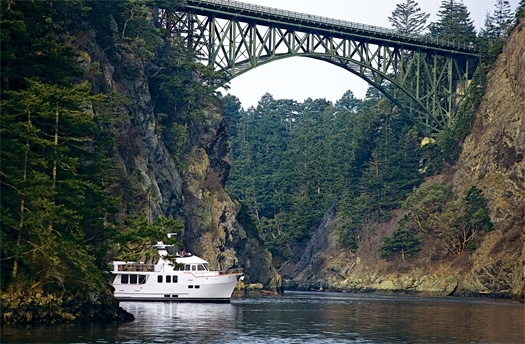
ytgjun09nmaine525.jpg
If you have watched the discovery channel series, The Deadliest Catch, you had to be appalled by the horrendous conditions that the crab fishermen endure on a daily basis while fishing the Bering sea. fierce winds, towering waves, and bitter cold are the norm. if you didn’t turn away from your television thinking, “Boy, am i glad i’m not out there in that stuff,” well, you weren’t paying attention.
So, it was particularly appropriate that my first sighting of the Northern Marine 64 Long Range Cruiser was while she was sharing a pier with Sea Star, the 104-foot crabber seen regularly on The Deadliest Catch. It was a most amazing contrast, because there were as many similarities between the vessels as there were differences.
Sea Star is a working vessel, bearing rust stains and scars from voyages in the North Pacific. Her topsides were dulled and her roughly welded pipe rails were coated in layers of chipped paint.
The Northern Marine 64, on the other hand, is clearly a yacht. Her topsides sparkled in the pale Seattle sunlight and the teak caprails gleamed to perfection.
But while one seemed to be wearing oily coveralls and the other was in a Dior suit, it was clear that they were sisters under the skin. Both were intended to go, as John Paul Jones said, “in harm’s way.” There is no way to catch crab without facing the brutal Bering Sea and the Gulf of Alaska. There is no way, even with modern weather forecasting, to do any serious cruising without catching the brunt of Mother Nature at some point.
There are many yachts on the market that claim to be “expedition cruisers” but few, if any, have the lineage of the Northern Marine 64. Her lines were clearly descended from those husky crabbers. But the real genesis for these yachts came in 1997 with Spirit of Zopilote, Bruce Kessler’s 64-foot Northern that built a reputation for ranging far and wide in all conditions. Since that time, Northern has continued to refine the concept in yachts from 57 feet to 86 feet, all bearing a look that stands out in any marina.
The tall, bluff bow is obviously meant to cleave green oceans and, from a floating pier, it seems impossibly high. When the seas are running to 40 feet, however, you’ll thank the crabbers for their foresight. Everything about the exterior of the Northern 64 reflects the focus on all-weather cruising. The teak-planked side decks have high bulwarks and stairways have well-spaced risers and sturdy, welded stainless steel handrails. And every deck has oversized scuppers to get rid of water quickly.
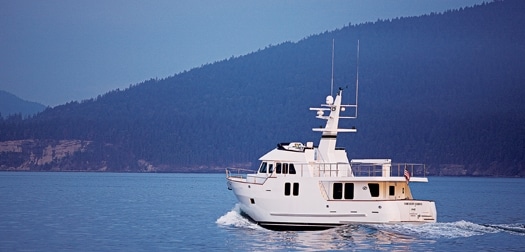
| | |
Boarding gates on each side deck make access to and from piers convenient, and the wide swim platform is perfect for reaching floating docks or tenders. Huge stainless steel hinges secure the transom door because, who knows, a rogue wave might just slap the stern hard. Centered in the transom is a massive, watertight Freeman door that opens to the lazarette and engineroom but, when closed and dogged, it might as well be a solid transom.
Whether you’re cruising the tropics under a burning sun or northern latitudes in steady drizzle, you’ll appreciate the protective overhang above the afterdeck. In fair weather, there is outdoor seating and a console that can be fitted as a wet bar.
It’s clear that the 64 LRC was designed for an experienced couple to handle by themselves, and you can move fore and aft on either side for line-handling. There’s no Portuguese bridge, but the pilothouse opens directly onto the foredeck level, with stairs leading up to the boat deck and then down to the afterdeck.
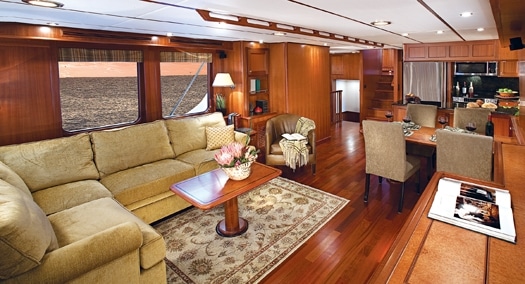
| | |
Another indication of her bluewater heritage is the salon door. It’s no flimsy slider, or even solid wood. It’s another aluminum Freeman door, set in a through-bolted aluminum frame, and complete with dogs, as well as the usual locking handle. Once inside, however, the salon is pure yacht. Styled by Ardeo Design, there is a wraparound settee to port, facing a low cabinet with a pop-up 37-inch television with a Bose Lifestyle entertainment package. A dining table for four fits neatly to starboard and the entire area is surrounded by large windows for good visibility, even when guests are seated.
Five steps above the salon is the heart of the Northern 64, and a fine pilothouse it is. This is clearly not Sea Star, where electronics and gear seem to be duct-taped and wired higgledy-piggledy. No, this is a carefully conceived and seamanlike helm, and Northern has the flexibility to tailor it to a skipper’s needs. One centerline Stidd helm chair was installed aboard this particular 64, but there is room for as many as three helm chairs, or a double-wide bench version.
The big stainless steel destroyer wheel divides the dashboard behind a windshield of five aft-raked panes of half-inch tempered glass. The leather-trimmed dashboard holds a full suite of electronics, including a trio of Hatland displays with picture-in-picture that all connect via NMEA 2000 busses for sharing information. On this 64, the electronics included a 72-mile Furuno radar that can be overlaid on Nobeltec Admiral charting software, a Furuno dual-frequency sounder, Furuno GPS, Icom VHF, Simrad autopilot, and remote cameras for engineroom and afterdeck.
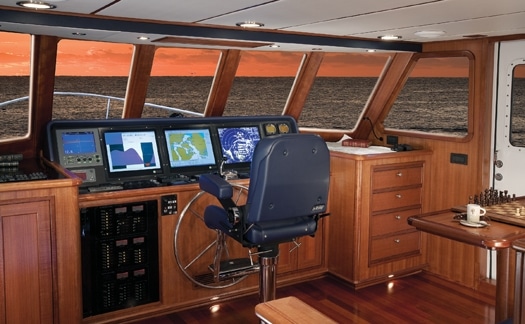
| | |
Arrayed on the horizontal dash are controls for the ABT bow and stern thrusters, Trac stabilizers, and a Simrad jog lever over the wheel. An interesting feature is that the thrusters can be powered by the generator or the main hydraulic PTO, and can be switched on from the helm at the touch of a button.
A full AC/DC panel (color coded for 120-240v AC and 24v DC) is backlit and clearly labeled, and a thoughtful backup is a separate battery with charger that can maintain power to the navigational electronics if there is a full electrical failure. Another redundancy is the twin helm pumps, one on the bridge and one in the pilothouse, to provide backup steering.
The port side of the pilothouse is a working area, with a large chart table outboard of the dash, and drawers for full-sized charts both under the nav area and under the raised settee. Aft of the sliding Freeman door is the ship’s office: a desk area with more stowage for books and papers.
The flying bridge has deep coamings topped by both a venturi windscreen and stainless steel rails. The fiberglass helm pod in the forward console duplicates the primary electronics from the lower helm, with an oversized destroyer wheel and twin Stidd chairs.
The boat deck is immense, with a 2,500-pound Steelhead davit on centerline, leaving room on each side for tenders, plus a fleet of kayaks or water toys. With the full 18 ½-foot beam available, a tender mounted athwartships could fit easily.
The foredeck is no less seamanlike, and the husky stainless steel breastplate around the anchor hawse to protect the topsides is just the first clue. A hydraulic Muir 3500 windlass was on this 64, fitted to carry 300 feet of 3/8-inch BBB chain. Against the house is a cavernous storage locker with gull-wing doors for stowing fenders and deck gear, plus connections for shore power, CATV, and phone.
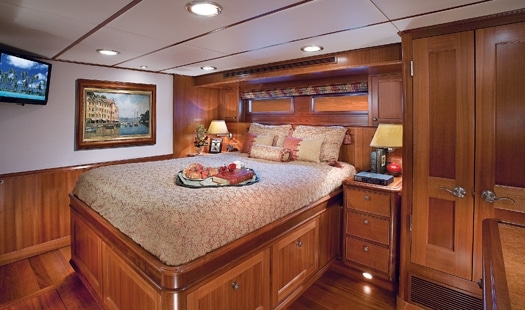
| | |
Several configurations are offered on the lower deck, with three en suite staterooms. On our test boat, the master suite was forward of amidships, with a king-sized berth, extensive hanging locker, and bureau space for liveaboards, as well as a nicely sized head with stall shower. Amidships, a guest suite essentially duplicated the master, and a third cabin in the forepeak had bunk beds for kids or crew.
The engineroom is entered through another Freeman watertight door with a sturdy porthole for checking the space before entering (a manual fire-suppression pull is also outside).
Centered in the full-headroom engineroom is the standard Volvo Penta D9 MH diesel that puts out a continuous-rated 355 horsepower at 1800 rpm. Twin 25 kW Northern Lights gensets are in sound boxes to port, and readily accessible. While some may worry about single-engine power, the Northern 64 has a Keypower hydraulic get-home drive that runs off the generator and that can generate speeds up to 4.5 knots.
Fuel is obviously a main concern on a long-range cruiser. The 64 LRC carries 3,100 gallons of diesel in two 700-gallon saddle tanks and a centerline 1,700-gallon bilge tank. Fuel transfer is easy and intuitive, with manifolding on the forward bulkhead that uses a 17-gpm Baldwin transfer pump. Seamanlike touches include an emergency bilge pump Y-valved off the main-engine water pump, with a large strum box in the forward sump.
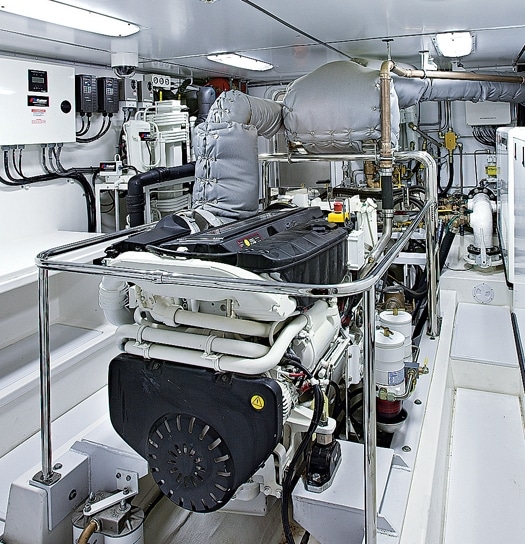
| | |
Underway, the Northern Marine 64 is just as solid as you’d expect from a yacht that weighs, oh, say, 80 tons. Even without the stabilizers, the 64 feels like a piece of Gibraltar. The top speed won’t blow off your hat, showing about 11 knots at 1600 rpm. But if you dial the speed back into the mid-8s, you’ll up the range to over 4,000 nautical miles-at which point you’ll probably want to get off and stretch your legs.
After my time aboard the Northern Marine 64, I paid a buck to get a guided tour of Sea Star. She had the rust and the patches and the dents that told of grim conditions far offshore, as well as a modicum of fame. But I realized that the Northern Marine 64 Long Range Cruiser was no less of an offshore voyager. The 64 LRC was well-built, better equipped, and vastly more luxurious.
Hands down I’d rather be aboard the Northern Marine 64.
Northern Marine, (360) 299-8400; **www.northernmarine.com**









